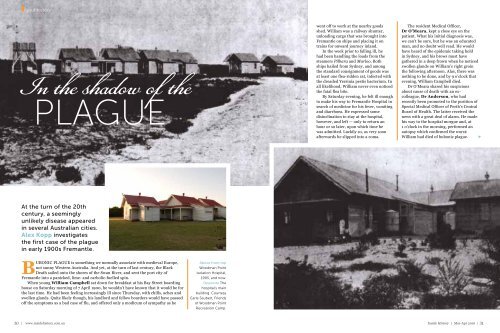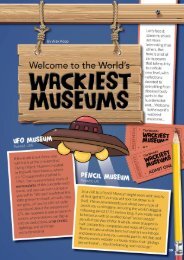In Shadow of the Plague Inside History
Create successful ePaper yourself
Turn your PDF publications into a flip-book with our unique Google optimized e-Paper software.
your history<br />
<strong>In</strong> <strong>the</strong> shadow <strong>of</strong> <strong>the</strong><br />
PLAGUE<br />
went <strong>of</strong>f to work at <strong>the</strong> nearby goods<br />
shed. William was a railway shunter,<br />
unloading cargo that was brought into<br />
Fremantle on ships and placing it on<br />
trains for onward journey inland.<br />
<strong>In</strong> <strong>the</strong> week prior to falling ill, he<br />
had been handling <strong>the</strong> loads from <strong>the</strong><br />
steamers Pilbara and Marloo. Both<br />
ships hailed from Sydney, and among<br />
<strong>the</strong> standard consignment <strong>of</strong> goods was<br />
at least one flea-ridden rat, infected with<br />
<strong>the</strong> dreaded Yersinia pestis bacterium. <strong>In</strong><br />
all likelihood, William never even noticed<br />
<strong>the</strong> fatal flea bite.<br />
By Saturday evening, he felt ill enough<br />
to make his way to Fremantle Hospital in<br />
search <strong>of</strong> medicine for his fever, vomiting<br />
and diarrhoea. He expressed some<br />
disinclination to stay at <strong>the</strong> hospital,<br />
however, and left — only to return an<br />
hour or so later, upon which time he<br />
was admitted. Luckily so, as very soon<br />
afterwards he slipped into a coma.<br />
The resident Medical Officer,<br />
Dr O’Meara, kept a close eye on <strong>the</strong><br />
patient. What his initial diagnosis was,<br />
we can’t be sure, but he was an educated<br />
man, and no doubt well read. He would<br />
have heard <strong>of</strong> <strong>the</strong> epidemic taking hold<br />
in Sydney, and his brows must have<br />
ga<strong>the</strong>red in a deep frown when he noticed<br />
swollen glands on William’s right groin<br />
<strong>the</strong> following afternoon. Alas, <strong>the</strong>re was<br />
nothing to be done, and by 9 o’clock that<br />
evening, William Campbell died.<br />
Dr O’Meara shared his suspicions<br />
about cause <strong>of</strong> death with an excolleague,<br />
Dr Anderson, who had<br />
recently been promoted to <strong>the</strong> position <strong>of</strong><br />
Special Medical Officer <strong>of</strong> Perth’s Central<br />
Board <strong>of</strong> Health. The latter received <strong>the</strong><br />
news with a great deal <strong>of</strong> alarm. He made<br />
his way to <strong>the</strong> hospital morgue and, at<br />
1 o’clock in <strong>the</strong> morning, performed an<br />
autopsy which confirmed <strong>the</strong> worst:<br />
William had died <strong>of</strong> bubonic plague.<br />
At <strong>the</strong> turn <strong>of</strong> <strong>the</strong> 20th<br />
century, a seemingly<br />
unlikely disease appeared<br />
in several Australian cities.<br />
Alex Kopp investigates<br />
<strong>the</strong> first case <strong>of</strong> <strong>the</strong> plague<br />
in early 1900s Fremantle.<br />
BUBONIC PLAGUE is something we normally associate with medieval Europe,<br />
not sunny Western Australia. And yet, at <strong>the</strong> turn <strong>of</strong> last century, <strong>the</strong> Black<br />
Death sailed onto <strong>the</strong> shores <strong>of</strong> <strong>the</strong> Swan River, and sent <strong>the</strong> port city <strong>of</strong><br />
Fremantle into a panicked, lime- and carbolic-fuelled spin.<br />
When young William Campbell sat down for breakfast at his Bay Street boarding<br />
house on Saturday morning <strong>of</strong> 7 April 1900, he wouldn’t have known that it would be for<br />
<strong>the</strong> last time. He had been feeling increasingly ill since Thursday, with chills, aches and<br />
swollen glands. Quite likely though, his landlord and fellow boarders would have passed<br />
<strong>of</strong>f <strong>the</strong> symptoms as a bad case <strong>of</strong> flu, and <strong>of</strong>fered only a modicum <strong>of</strong> sympathy as he<br />
Above from top<br />
Woodman Point<br />
Isolation Hospital,<br />
1905, and now.<br />
Opposite The<br />
hospital’s main<br />
building. Courtesy<br />
Earle Seubert, Friends<br />
<strong>of</strong> Woodman Point<br />
Recreation Camp.<br />
30 | www.insidehistory.com.au <strong>In</strong>side <strong>History</strong> | Mar-Apr 2016 | 31
Bubonic plague<br />
in Australia<br />
The first quarter <strong>of</strong> <strong>the</strong> 20th<br />
century saw 12 major plague<br />
outbreaks across Australia.<br />
The disease, which resulted<br />
in 1,371 reported cases and<br />
535 deaths nationwide,<br />
was introduced into <strong>the</strong><br />
country by infected rats from<br />
overseas ship arrivals. Sydney<br />
was most affected, but<br />
<strong>the</strong> disease also spread to<br />
Queensland with occasional<br />
cases found in Melbourne,<br />
Adelaide, Perth, Kalgoorlie<br />
and Fremantle.<br />
take <strong>the</strong> cadaver 20 miles out to sea.<br />
And so, <strong>the</strong> body was wrapped in three<br />
layers <strong>of</strong> heavy blankets, each soaked in<br />
a strong disinfecting solution <strong>of</strong> carbolic<br />
acid, <strong>the</strong>n placed in a heavily weighted<br />
and perforated c<strong>of</strong>fin and lowered into<br />
<strong>the</strong> ocean.<br />
One would have hoped that was <strong>the</strong><br />
end <strong>of</strong> <strong>the</strong> matter. Alas, panic, once<br />
in motion, takes a while to slow down<br />
and subside. Fear spread about fish<br />
and crustaceans feeding on <strong>the</strong> body<br />
and seafood all but vanished from<br />
local menus. This was observed with<br />
a great deal <strong>of</strong> angst and bitterness by<br />
local fishermen, <strong>the</strong> lifeblood <strong>of</strong> <strong>the</strong><br />
community, who noted that <strong>the</strong> chosen<br />
method <strong>of</strong> William’s burial practically<br />
extinguished <strong>the</strong>ir trade. Many boats<br />
stayed in port, as it was neigh impossible<br />
for fishermen to sell <strong>the</strong>ir catch.<br />
Fremantle was on tenterhooks, waiting.<br />
And <strong>the</strong>n, on 12 April, a shadow spread<br />
over <strong>the</strong> city as <strong>the</strong> second victim fell.<br />
The shadow remained for <strong>the</strong> next<br />
six years. It hung, heavy and gloating,<br />
as more cases appeared: four, five, six...<br />
It watched over frantic efforts to clean<br />
<strong>the</strong> streets and docks, and over macabre<br />
<strong>In</strong>dian pyres upon which bodies burned<br />
Useful resources<br />
• Learn about <strong>the</strong> fascinating history <strong>of</strong> <strong>the</strong> Woodman<br />
Point Quarantine Station in Western Australia;<br />
woodmanpointquarantinestation.com<br />
• State Records NSW has some chilling photographs<br />
<strong>of</strong> Sydney in <strong>the</strong> grips <strong>of</strong> <strong>the</strong> plague; gallery.<br />
records.nsw.gov.au/index.php/galleries/purgingpestilence-plague<br />
• Read a quick overview <strong>of</strong> <strong>the</strong> plague today and<br />
in <strong>the</strong> past; science.nationalgeographic.com/<br />
science/health-and-human-body/humandiseases/plague-article<br />
— for William’s burial at sea was not<br />
repeated. It watched, as <strong>the</strong> quarantine<br />
station was built at Woodman Point,<br />
replete with a hospital to treat those cases<br />
that could be saved, and a crematorium,<br />
for those who could not. Eventually, in<br />
1906, as <strong>the</strong> ashes <strong>of</strong> <strong>the</strong> 29th victim<br />
slowly cooled, <strong>the</strong> shadow finally lifted. <br />
*<br />
Alex Kopp is a writer and<br />
educator. Visit her blog,<br />
writilin.com.au<br />
Below Pr<strong>of</strong>essional<br />
ratcatchers in<br />
Sydney, 1900.<br />
Courtesy State<br />
Library NSW.<br />
Degotardi_a147264<br />
Top and above Woodman Point Quarantine<br />
Station Crematorium, completed in 1901.<br />
Courtesy Earle Seubert, Friends <strong>of</strong> Woodman<br />
Point Recreation Camp <strong>In</strong>c.<br />
A report bearing <strong>the</strong> news was quickly sent up <strong>the</strong> line, to<br />
<strong>the</strong> Principal Medical Officer, Dr Harvey. Upon learning <strong>of</strong> <strong>the</strong><br />
situation, he, in turn, put <strong>the</strong> entire city on full alert. All manner<br />
<strong>of</strong> crisis control measures were immediately put into effect.<br />
Wharfs were scrubbed, access to <strong>the</strong> inter-colonial shipping<br />
docks was limited, incoming steamers were subjected to strict<br />
fumigation, and mass efforts were coordinated to trap rats which<br />
roamed <strong>the</strong> city. A few days after William’s death, <strong>the</strong> West<br />
Australian reported that government <strong>of</strong>ficials had<br />
‘a tolerably free hand in <strong>the</strong> expenditure <strong>of</strong> public funds’ when<br />
it came to carrying out prevention and control measures. Some<br />
<strong>of</strong> <strong>the</strong>se funds were directed towards urgent and immediate<br />
construction <strong>of</strong> a quarantine station and cremation facilities<br />
at Woodman Point, south <strong>of</strong> Fremantle.<br />
Immediate orders were issued to isolate William’s lodgings,<br />
hospital room and <strong>the</strong> morgue. The morgue would later be<br />
burned, as would all <strong>of</strong> <strong>the</strong> victim’s bedding and belongings. The<br />
walls in William’s room were stripped <strong>of</strong> paper and scrubbed, and<br />
similar treatment was applied to <strong>the</strong> ceiling, floors and woodwork.<br />
The whole house was fumigated with sulphur for 12 hours.<br />
A decision needed to be made as to <strong>the</strong> best way to dispose <strong>of</strong><br />
poor William. Burial was out <strong>of</strong> <strong>the</strong> question, for fear <strong>of</strong> bacterial<br />
contamination <strong>of</strong> <strong>the</strong> soil and ground water. With no existing<br />
crematorium in Fremantle, <strong>of</strong>ficials approved a suggestion to<br />
32 | www.insidehistory.com.au <strong>In</strong>side <strong>History</strong> | Mar-Apr 2016 | 33



